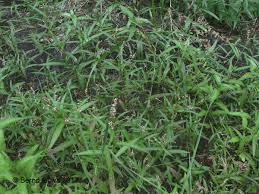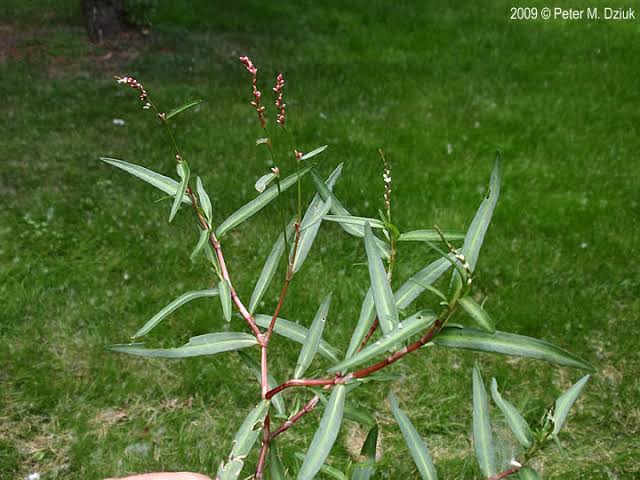Persicaria minor, commonly known as Knotweed or Bitter Knotgrass, is a herbaceous plant belonging to the Polygonaceae family. This annual herb is known for its widespread presence in many parts of the world, particularly in Asia. It typically grows in damp or marshy areas, making it a common sight near water bodies, including streams and rice paddies.
The plant’s leaves are lance-shaped, and its stems can reach varying heights, often ranging from 15 to 60 centimeters. Persicaria minor is appreciated for its culinary and medicinal uses, with a slightly bitter taste that adds flavor to traditional dishes.
In traditional medicine, Persicaria minor has been utilized for its potential health benefits. It is rich in various bioactive compounds, including antioxidants and phytochemicals. Some communities use it to address digestive issues and as a natural remedy for diarrhea and stomach discomfort.
Moreover, the plant is valued for its antimicrobial properties and has been applied topically to manage skin conditions. Its versatility extends to culinary use, where it features in a range of recipes, from soups and salads to stir-fried dishes. The herb’s slightly bitter taste contributes a unique flavor dimension to these culinary creations.
Despite its benefits, it’s important to use Persicaria minor in moderation, as excessive consumption can lead to adverse effects. Additionally, while it has been traditionally used in various cultures.
It’s advisable to consult with a healthcare professional before incorporating it into your diet or using it for medicinal purposes. Its presence in traditional practices and cuisines highlights its significance and versatility, making it a herb of cultural and culinary value.
The Botanical Description of Persicaria minor
1. Plant Structure: Persicaria minor is an annual herb with herbaceous growth, typically reaching a height of 15 to 60 centimeters.
2. Leaves: The plant features lance-shaped leaves that are green and possess a slightly bitter taste.
3. Stems: Its stems are often slender, erect, and can vary in height.
4. Flowers: Persicaria minor produces small, inconspicuous flowers that are usually pinkish or white in color.
5. Habitat: This plant is commonly found in damp or marshy areas, making it prevalent near water bodies, including streams, rice paddies, and wetlands.
The Geographic Distribution of Persicaria minor
1. Native Range: Persicaria minor is native to Asia and has a widespread distribution across the continent.
2. Common Countries: It is commonly found in countries such as India, Bangladesh, China, Malaysia, and Thailand.
3. Habitat Diversity: The plant’s adaptability to various environmental conditions allows it to thrive in diverse habitats, from rural agricultural fields to urban areas with marshy land.
4. Ubiquity: Its adaptability and resilience have led to its presence in many regions of Asia, where it plays a role in traditional cuisine and herbal medicine.
The Chemical Composition of Persicaria minor
1. Bioactive Compounds: Persicaria minor contains a range of bioactive compounds, including antioxidants, flavonoids, and phytochemicals.
2. Quercetin Content: Notably, it contains quercetin, a flavonoid known for its antioxidant and anti-inflammatory effects.
3. Traditional Uses: Quercetin may contribute to its traditional use for digestive issues and as an anti-diarrheal remedy.
4. Astringent Properties: The plant’s chemical composition includes tannins, which provide astringent properties and may be applied in traditional medicine.
Health Benefits and Traditional Uses of Persicaria minor
1. Digestive Aid: Persicaria minor is traditionally used to alleviate mild digestive discomfort and enhance appetite, often consumed as a tea or in combination with other herbs.
2. Anti-Diarrheal Properties: It is recognized for its anti-diarrheal properties and is employed to manage loose stools and gastrointestinal discomfort.
3. Skin Conditions: In some cultures, Persicaria minor is applied topically to manage skin conditions due to its potential anti-inflammatory properties.
4. Culinary Use: The slightly bitter taste of Persicaria minor adds a unique flavor to various dishes, and it is used in traditional cuisine, including soups, salads, and stir-fried dishes.
5. Antioxidant Properties: The presence of quercetin and other antioxidants in Persicaria minor contributes to its potential antioxidant effects, which may help combat oxidative stress.
It’s essential to use Persicaria minor in moderation, as excessive consumption may lead to adverse effects. Consulting with a healthcare professional before using it for medicinal purposes is advisable, and considering its cultural and culinary significance adds to its value as a versatile herb.
Read Also: 15 Medicinal Health Benefits of Thermopsis rhombifolia (Golden bean)
The Medicinal Health Benefits of Persicaria minor (Knotweed)

1. Gastrointestinal Relief: Persicaria minor is revered for its ability to provide relief from gastrointestinal discomfort. It is known to soothe digestive issues, such as indigestion and mild stomach upset.
2. Anti-Diarrheal Properties: One of the prominent health benefits is its effectiveness in managing diarrhea. It can help regulate bowel movements and reduce the frequency of loose stools.
3. Skin Health: In some traditional practices, Persicaria minor is applied topically to the skin to address various skin conditions. Its potential anti-inflammatory properties make it a choice for managing skin discomfort.
4. Appetite Enhancement: It is used as a digestive aid and is believed to stimulate the appetite, making it valuable for those experiencing reduced food intake.
5. Antioxidant Effects: Persicaria minor contains antioxidants, including quercetin, which help combat oxidative stress and protect the body’s cells from damage.
Methods of Usage to Achieve the Provided Health Benefits of Persicaria minor (Knotweed)
1. Herbal Infusion: To harness its digestive and anti-diarrheal benefits, prepare an herbal infusion by steeping Persicaria minor leaves in hot water. Strain and consume as a tea.
2. Topical Application: For skin health, crush the leaves and apply the paste to affected areas. Ensure you do a patch test and consult with a healthcare professional or dermatologist.
3. Culinary Use: Incorporate Persicaria minor in your culinary creations. It can be added to soups, salads, and stir-fried dishes to enhance flavor.
4. Dosage Considerations: When using Persicaria minor for its medicinal benefits, it’s essential to follow recommended dosages. Consult with an herbalist or healthcare provider for guidance.
Side Effects of Using Persicaria minor Medicinal Plant
1. Potential Allergic Reactions: Some individuals may experience allergic reactions to Persicaria minor, which could manifest as skin rashes or gastrointestinal discomfort. If you have a history of allergies, use with caution.
2. Overconsumption: Excessive consumption of Persicaria minor, especially in its raw form, may lead to adverse effects. It’s crucial to use this herb in moderation and within recommended limits.
3. Interactions: If you are taking medications or have underlying health conditions, consult with a healthcare professional before using Persicaria minor for medicinal purposes. It may interact with certain drugs.
4. Skin Sensitivity: When applying Persicaria minor topically, do a patch test on a small area of your skin to ensure you do not develop adverse reactions.
5. Pregnancy and Lactation: Pregnant and breastfeeding individuals should exercise caution and consult with a healthcare provider before using Persicaria minor for any purpose.
Using Persicaria minor responsibly and with proper guidance can help you harness its potential health benefits while minimizing the risk of adverse effects. Always prioritize safety and seek professional advice when in doubt.
Read Also: 7 Medicinal Health Benefits Of Ribes divaricatum (Straggly Gooseberry)
Scientific Research and Studies of Persicaria minor

1. Gastrointestinal Benefits: Numerous scientific studies have explored the traditional use of Persicaria minor for gastrointestinal health. Research indicates its potential to reduce symptoms of indigestion and enhance appetite. Studies on animal models have shown promising results in reducing gastric discomfort.
2. Anti-Diarrheal Properties: Scientific investigations have focused on the anti-diarrheal effects of Persicaria minor. Compounds like tannins and quercetin found in the plant have been studied for their role in regulating bowel movements. Clinical trials in this area are limited but suggest potential benefits.
3. Antioxidant Activity: Several studies have delved into the antioxidant properties of Persicaria minor. Its quercetin content, in particular, has attracted attention due to its ability to combat oxidative stress. These antioxidants are believed to contribute to overall health and well-being.
4. Traditional Usage Validation: Scientific research has attempted to validate the traditional uses of Persicaria minor. While many findings align with its historical applications, further clinical trials and studies are needed to establish its efficacy in a broader context.
5. Safety and Toxicology: Research on the safety profile and toxicology of Persicaria minor is essential. While it is generally considered safe when used as a culinary herb or in moderation for medicinal purposes, rigorous safety assessments provide valuable insights.
Safety Precautions and Recommendations in Using Persicaria minor Medicinal Plant
1. Allergy Assessment: Before using Persicaria minor, it’s crucial to determine if you have any allergies to the plant. Perform a skin patch test or seek guidance from a healthcare provider if you suspect allergies.
2. Dosage Guidance: For medicinal applications, consult with an herbalist or healthcare professional to determine the appropriate dosage. Overconsumption may lead to adverse effects.
3. Interactions: If you are taking medications or have existing health conditions, consult with a healthcare provider before incorporating Persicaria minor into your health regimen. It may interact with certain drugs.
4. Pregnancy and Lactation: Pregnant and breastfeeding individuals should exercise caution and seek professional advice before using Persicaria minor. Limited data are available on its safety during these stages.
5. Skin Application: When applying Persicaria minor topically, always perform a patch test on a small area of skin to ensure you do not develop adverse reactions or skin sensitivities.
FAQs About Persicaria minor Medicinal Plant
1. Is Persicaria minor safe for daily consumption?
It is generally safe for culinary use, but when used medicinally, it’s advisable to follow recommended dosages and consult with a healthcare provider.
2. Can Persicaria minor be used to treat severe diarrhea?
While it may help manage mild diarrhea, it is not a substitute for medical treatment in cases of severe or persistent diarrhea.
3. Are there any contraindications for using Persicaria minor with other medications?
There may be interactions with certain medications. Consult with a healthcare provider to ensure safety.
4. Is Persicaria minor suitable for children?
It’s essential to use it cautiously with children and consult with a pediatrician before use.
5. Can Persicaria minor be applied to sensitive skin?
Always perform a patch test to assess skin sensitivity. If adverse reactions occur, discontinue use and consult a dermatologist.
6. Where can I find Persicaria minor if it’s not locally available?
You may find it in Asian grocery stores or consider cultivating it in a controlled environment at home.
7. What is the best way to prepare Persicaria minor for culinary use?
It can be used in various dishes, such as soups, salads, and stir-fried dishes. The leaves can be added directly to recipes to impart flavor.
8. How does Persicaria minor compare to other herbs in terms of antioxidant content?
While it contains antioxidants like quercetin, its concentration may vary. It is one of many herbs valued for its potential health benefits.
9. Are there any ongoing clinical trials involving Persicaria minor?
Clinical trials are limited, and more research is needed to fully understand its therapeutic potential. Keep an eye on current scientific studies for updates.
10. Can I cultivate Persicaria minor at home?
Yes, it can be cultivated in a home garden. Ensure it receives adequate moisture and sunlight for optimal growth.
Read Also: Interesting Facts About Giraffe

